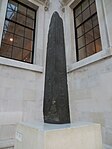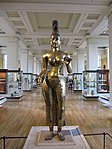The Revells of Christendome
1609 drawings17th-century engravingsCultural depictions of Christian IV of DenmarkCultural depictions of Dutch kingsCultural depictions of French kings ... and 4 more
Cultural depictions of James VI and IPrintmaking stubsPrints and drawings in the British MuseumRenaissance prints

The Revells of Christendome is an engraving by English engraver Thomas Cockson. With image size of 21.6 x 35.5 cm and overall measure of 29.2 x 37.2 cm, A copy is in the collection of the Department of Prints and Drawings of the British Museum.
Excerpt from the Wikipedia article The Revells of Christendome (License: CC BY-SA 3.0, Authors, Images).The Revells of Christendome
Great Court, London Bloomsbury (London Borough of Camden)
Geographical coordinates (GPS) Address Nearby Places Show on map
Geographical coordinates (GPS)
| Latitude | Longitude |
|---|---|
| N 51.519444444444 ° | E -0.12691666666667 ° |
Address
Reading Room
Great Court
WC1B 3DE London, Bloomsbury (London Borough of Camden)
England, United Kingdom
Open on Google Maps









